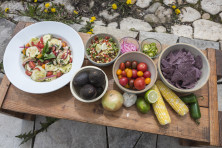Chianti with Britton Unkefer of the Wild Tomato
- Share
- Tweet
- Pin
- Share
Sometimes called the Bordeaux of Italy, Chianti is probably one of the most recognized wines in the world. Produced exclusively in Tuscany, the first definition of a wine-area called Chianti was made in 1716, describing the area near the villages of Gaiole, Castellina and Radda. In 1932, the area was divided into approved sub-regions as follows:
• Chianti Classico
• Chianti Montalbano
• Chianti Colli Fiorentini (Florentine Hills)
• Chianti Rufini
• Colli Senesi (Siena Hills)
• Colline Pisane (Pisan Hills)
• Colli Aretini (Arezzo Hills)
• Chianti Montespertoli
Chianti’s wine requirements have undergone some changes over the years. Originally, Chiantis were produced following a strict recipe requiring winemakers to use 70 percent Sangiovese, 15 percent Canaiolo, 10 percent Malvasia and 5 percent other local red varieties. In 1967, the Denominazione di origine controllata (DOC) regulation set by the Italian government firmly established the “Ricasoli formula” of a Sangiovese-based blend with 10 – 30 percent Malvasia and Trebbiano. In 1996, the blend for Chianti and Chianti Classico was modified to allow 75 – 100 percent Sangiovese, up to 10 percent Canaiolo and up to 20 percent of any other approved red grape variety such as Cabernet Sauvignon, Merlot or Syrah. Oddly, since 2006 the use of white grape varieties such as Malvasia and Trebbiano has been prohibited in wines labeled Chianti Classico.
Chianti can come in a wide variety of styles, due to the flexibility in the blending recipe. Lighter bodied styles will generally have a higher proportion of white grape varieties blended in, while Chiantis that have only red grape varieties will be fuller and richer. Basic level Chianti is often characterized by its juicy fruit notes of cherry, plum and raspberry. Young Chianti wines can have a predominantly floral and cinnamon spicy bouquet, and as the wine matures, tobacco and leather aromas tend to emerge.
Most Chiantis have medium-high acidity and medium-soft tannins, which is what makes them very flexible with wine and food pairings, especially when it comes to typical Italian cuisine that features tomato-based sauces. Chiantis are at their peak often between three and five years after vintage, with premium examples having the potential to age four to eight years. Well-made examples of Chianti Classico often have the potential to age and improve in the bottle for six to 20 years.
Wines labeled Chianti Superiore can be produced only from grapes cultivated in the Chianti wine areas, except from those vineyards that are registered in the Chianti Classico sub-zone. Chianti Superiore wines must be produced with the following grapes:
• Sangiovese: min. 75 percent
• Canaiolo Nero: max. 10 percent
• Trebbiano Toscano and Malvasia del Chianti: max. 10 percent
• Other authorized red grapes: max. 20 percent
Chianti Superiore cannot be sold to the consumer before nine months of aging, of which three must be in the bottle. Therefore it cannot be bottled before the June after picking or sold to consumers before the next September, as aging is calculated from January 1 after the picking.
While many people associate Chianti wines with those bottles wrapped in woven straw, (fiascos), most Chiantis today are bottled in traditional glass, similar in shape and color to Bordeaux bottles. You may notice a black rooster (gallo nero in Italian) that appears on the neck labels of many Chianti Classico’s. This is the symbol of the Consorzio Chianti Classico, a foundation of producers in the Chianti Classico region whose aim is promoting the wines of the region, improving quality and preventing wine fraud.
Fattoria Bibbiani Poggio Vignoso Chianti Italy 2008
“This Chianti is a nice dark plum color with some aromas of black cherry and just a hint of tobacco. The wine is well balanced with acidity and some soft tannins, making this a very easy wine to pair with a variety of foods. The black cherry notes carry through to the finish along with some hints of subtle leather and a nice black pepper spice. The acidity is pronounced but not overbearing and is balanced nicely with the soft tannins that come though right at the finish. I would pair this wine with our Caprese salad with fresh mozzarella and sliced tomatoes drizzled with olive oil and balsamic vinaigrette or the veggie cobb salad with wood-fire grilled bell peppers, tomatoes, mushrooms, artichokes, black olives and mozzarella cheese served over mixed greens. As far as our pizzas, I would suggest the Fun Guy pizza with a blend of five mushrooms, caramelized onions, spinach and a garlic cream cheese or even the sausage and pesto pizza with fresh roma tomatoes and fresh basil would do well by this Chianti also.”
~ Britton Unkefer, The Wild Tomato Wood-Fired Pizza and Grill (Fish Creek)
Appearance: A rich, dark plum color
Aroma: Nice black cherry and hints of tobacco
Flavors: The black cherry flavors continue with a touch of leather and black pepper spice
Finishing Notes: Balanced acidity with soft tannins
Where to Buy: Main Street Market
Where to Try: The Mission Grille and Pasta Vino
Information about “Where to Try” and “Where to Buy” these selected wines was provided by the local wine purveyors and vendors. If you happen to also serve or sell these wines, email [email protected].
WINE:30 is written by Karl Bradley and Jody Wuollett. Karl is the general manager and self-proclaimed “sous” sommelier for the Mission Grille. Former restaurant executive and Door County native Jody is happily under-employed as a Mission Grille food server and a member of the local band Northbound.



